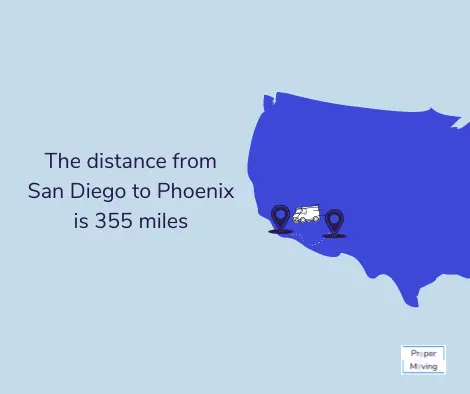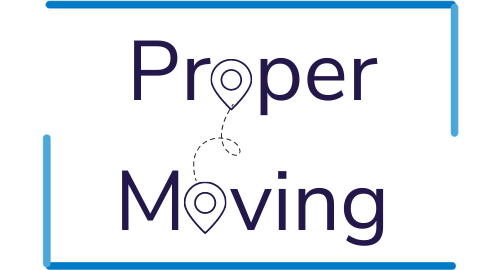Moving from San Diego to Phoenix can be a huge change for some people, especially if hot summers are not your thing.
But generally, the cities share many similarities. Both cities are relatively close to the US-Mexico border and have roughly the same population.
These similarities may help you to adapt to life in Phoenix much faster, but the quality of life in Arizona differs from the quality of life in California.
So if you’re planning on trading in the Birthplace of California for the Valley of the Sun, this guide will help you have the most stress-free relocation as possible.
The Moving Process From San Diego to Phoenix
How Far is Phoenix from San Diego?
The distance between San Diego and Phoenix is 355 miles. The driving time of this journey is approximately 5 hours and 25 minutes by car depending on traffic.

It’s a manageable drive so whether you’re planning on doing a Do It Yourself move in a rented moving van and driving the whole journey yourself. Or maybe you’re planning to hire a professional moving company and drive your car yourself, it’s worth noting that it’s not too long of a drive.
The flight time is roughly 1 hour and 20 minutes long, so if the idea of driving for 5+ hours in a rented truck doesn’t appeal to you, you should probably fly instead.
What is the Average Cost to Move From San Diego to Phoenix?
The average cost to move from San Diego to Phoenix is between $2,800-$6,700. So the average cost is around $4,733.

Keep in mind that many variables determine the exact cost of a move from San Diego to Phoenix. Such as the number of items being moved, whether you might require packing and unpacking services, the dates of the move, and whether you’re planning a DIY move or hiring a professional moving company to help you.
Should I Move From San Diego to Phoenix?
This move might be a massive change for some people, but there are so many benefits to relocating to Arizona. Massive decreases in housing costs and hotter summers are two of the biggest benefits. If this sounds good to you, then you should move from San Diego to Phoenix.
How San Diego Compares to Phoenix
Living Costs Compared
The first thing one will notice after moving from San Diego is that things cost significantly less in Phoenix.
Living in California can have its perks, but it can be pricey. So if you decide to move to Phoenix, you’re in for a pleasant surprise because housing costs will be a whopping 63% cheaper than in San Diego.
The median rent in San Diego is around $2,615 per month. While in Phoenix, the average rent per month is $1,554.
If you’re planning to buy real estate in Phoenix, you’ll be happy to know that buying a house in Phoenix is around 2.7 times cheaper. In San Diego, the median sale price for a home is around $645,300. And in Phoenix, the median sale price of a house is only $239,400.
Entertainment, transport, and food costs are all cheaper in Phoenix than they are in San Diego so expect to have an overall general lower cost of living.
Public Transportation
Valley Metro is Phoenix’s public transport system which consists primarily of buses, and a 20-mile light rail system. It serves Phoenix and the greater area.

Phoenix Dial-A-Ride is a service that provides public transportation for people with disabilities within the Phoenix area. The service is available 7 days a week and operates from 5 am-10 pm. You must schedule your ride in advance.
In San Diego, a Regional Adult 30-Day Pass is $72 and a One-Way MTS ticket costs $2.50. In Phoenix, you can expect a lot cheaper fares because a 31-Day Pass for Local Bus and Light Rail costs only $64 and one ride costs $2.00.
Weather
Phoenix has hotter summers than San Diego, so if you love those hotter days in the summer months you’re in luck.
The summers in Phoenix hit average highs of around 105℉. San Diego’s summers are milder, with the average high in July reaching around 79℉.

Both San Diego and Phoenix get no snowfall throughout the year, so there won’t be much to adjust to on that front. San Diego and Phoenix have milder winter months too with both of their January average temperatures reaching the mid-40s.
Moving From San Diego to Phoenix DMV
If you plan to move from San Diego to Phoenix, please note that you’ll need to get a new driver’s license.
After becoming a resident in Arizona, you must visit the DMV to obtain your initial driver’s license and title, and registration.
More information about what you will need to bring with you to your appointment can be found here.
Buying a home in Phoenix
As mentioned previously, buying a home in Phoenix is undoubtedly cheaper than buying a home in San Diego. So if you are looking to purchase a home in Phoenix, the following neighborhoods are the best to consider.
Desert View
Desert View was named as the number one neighborhood to buy a home in Phoenix on Niche. This is an excellent neighborhood for expanding families.
Are you looking to buy a home in a neighborhood with a high instance rate of homeownership? Then you’ll love Desert View, since 73% of homes are owner-occupied.
Many houses in this neighborhood are part of gated communities that have playgrounds, community swimming pools, grills, and tables for parties. These amenities will hopefully make it easy for you and your family to establish a sense of community.
Ahwatukee Foothills
Are you looking for a community that feels safe and secure? Then Ahwatukee Foothills is the Phoenix suburb for you. It has been rated as an extremely safe place to live by its residents are crime rates are low. The overall atmosphere of the area is family-oriented and calm.
It will appeal to those who love spending time outdoors, as there are so many parks and recreation areas nearby that offer spaces for various activities to take place.
Downtown Scottsdale
Are you a young professional on the hunt for a chic neighborhood to buy a home in? Downtown Scottsdale is the best neighborhood for you to consider when searching for property. The housing stock here consists of luxury apartment complexes or converted lofts.
The bustling area contains an energetic art scene and a hoard of trendy drinking and dining establishments. So if you’re a millennial looking for a neighborhood to call home, Downtown Scottsdale might be right up your street.
Selling Your Property in San Diego
If you have decided to sell your property in San Diego, the first step in selling is finding an experienced and knowledgeable realtor.
Once you have chosen the right realtor for you, it’s time to decide when the right time is to sell. According to housing transaction data in the San Diego area, July is the best month of the year to list your home. If you decide to list your home in July, you can expect to make 2.80% more than the yearly average. Generally, it takes 3 months to close on a sale in San Diego, so the best month to sell would be October.
Before you make your sale listing, you must gauge what your property is worth. Your realtor should assist you by assessing the market and drafting a market analysis. Once they have helped you gauge what your property is worth, you can then confidently price your home.
Finding a Job in Phoenix Before You Move There
The job market in Phoenix has options within a wide range of industries. The following places may help you in the search for a new job;
City of Phoenix
With more than 14,000 employees employed across 35 departments, this Career Center is a great place to start the job search within the City of Phoenix.
Indeed
Indeed is usually one of the best places to start the job searching process, no matter where you are. Make sure to use the tools to filter your search to certain areas in Phoenix, this will help you to narrow down the whopping 58,000 jobs that are currently listed.
To see the current job listings available in Phoenix, click here.
Word of Mouth
Do you know anyone that lives in Phoenix? Reach out to them and ask them if they know anyone that’s looking to hire.
Moving From San Diego to Phoenix Checklist
The following checklist can be used to check all the things that need to be done before moving from San Diego to the Valley of the Sun.
At Least 4 to 6 Weeks Before the Move
– Organize a professional moving company.
– Let your health care physician, dentist, and other service providers know that you are moving.
– Order moving supplies or ask your moving company to provide them as an additional service
– It is a great idea to sell or donate your unwanted items. You can sell on Facebook Marketplace or Craigslist. Or you can donate them to the Salvation Army and they will pick items up at no charge.
– Begin packing; clearly mark boxes with a marker indicating which room they will be going into at delivery.
– You will need to make your change of address known to several different places, such as wherever you do your banking, the DMV, your workplace, any other financial institutions (such as credit card providers), the post office, your utility provider, and, saving the most important for last, your friends and family.
– Sort plane tickets if you’re planning to fly.
2 Weeks Prior to the Move
– It is imperative to clean and/or make needed repairs on your old home before moving out, since leaving your place an absolute mess may leave your security deposit in jeopardy.
– Because of the abundance of fragile items in your kitchen, you’ll want to pack these items away long in advance, with protective bubble wrap to ensure nothing gets broken in transit.
– You will also want to begin packing your things from bedrooms and bathrooms, except for your essential items that you will be using until you move.
– If necessary, you will want to arrange a babysitter for your kids and/or pets for parts of the move that you need to be able to focus and get things done.
A Couple of Days Before Your Move
– Clean up your home completely, double checking any cracks and crevices that may have your stuff hidden away.
– Unless your movers will do it for you, dissassemble your furniture to make your move a smoother process, and ensure to keep any screws, brackets, or other small items that are needed for reassembly. Pro tip: tape these smaller items in a bag to the bottom of the furniture.
– Print out the floor plan of your new home and have enough for the movers as well.
– You may want to hit the ATM before moving day, as you’ll need to have enough cash to tip your movers. Generally speaking, you’ll want to tip $20-$30 per mover.
– Make sure that you confirm with your movers the details of your move. The last thing that you want is to have moving day come around, and you and your movers aren’t on the same page.
– Get in touch with the landlord or current homeowner of your new place, and ensure that you’ll be able to get the keys to your new place when you arrive.
– Document the condition of your old place through pictures and videos, to ensure that you have proof of its state. This will come in handy if your landlord tries to keep your deposit, based on incorrect facts.
Moving Day
– Hand over your old home’s keys to the necessary people, such as landlord or building management.
– Do a quick run-through of your home to ensure that nothing gets left behind, whether it’s just a smaller item, or an entire box of stuff.
– Ensure that everything you packed up is in your new home before unpacking everything.
– If the moving company you are working with is going to assemble your furniture, make sure that they reassemble it in the correct room to avoid unnecessary work.
– Be sure to thank everyone helping you move, and leave them a tip!
You did it! Congrats and enjoy your new home!
RELATED POSTS:
Moving From New York City to San Francisco
Moving From San Francisco to Portland
Moving From New York City to Miami


Recent Comments